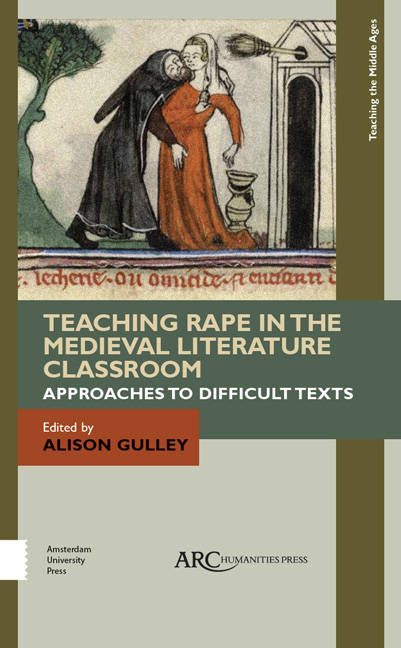Book contents
- Frontmatter
- Contents
- Acknowledgements
- Chapter 1 Introduction: Teaching Rape and Meeting the Challenges of the TwentyFirstCentury Classroom
- Chapter 2 Medieval Saints and Misogynist Times: Transhistorical Perspectives on Sexual Violence in the Undergraduate Classroom
- Chapter 3 Teaching Medieval Rape Culture across Genre: Insights from Victimology
- Chapter 4 Bringing the Bystander into the Humanities Classroom: Reading Ancient, Patristic, and Medieval Texts on the Continuum of Violence
- Chapter 5 From Bystander to Upstander: Reading the Nibelungenlied to Resist Rape Culture
- Chapter 6 Speech, Silence, and Teaching Chaucer’s Rapes
- Chapter 7 Classroom PSA: Values, Law, and Ethics in “The Reeve’s Tale”
- Chapter 8 “How do we know he really raped her?”: Using the BBC Canterbury Tales to Confront Student Skepticism towards the Wife of Bath
- Chapter 9 Teaching the Potiphar’s Wife Motif in Marie de France’s Lanval
- Chapter 10 Sexual Compulsion and Sexual Violence in the Lais of Marie de France
- Chapter 11 Troubadour Lyric, Fin’amors, and Rape Culture
- Chapter 12 The Knight Coerced: Two Cases of Raped Men in Chivalric Romance
- Chapter 13 Teaching Rape to the HeMan Woman Haters Club: Chrétien de Troyes at a Military School
- Chapter 14 Rape, Identity, and Redemption: Teaching “Sir Gowther” in the Community College Classroom
- Notes on Contributors
- Index
Chapter 8 - “How do we know he really raped her?”: Using the BBC Canterbury Tales to Confront Student Skepticism towards the Wife of Bath
Published online by Cambridge University Press: 23 January 2021
- Frontmatter
- Contents
- Acknowledgements
- Chapter 1 Introduction: Teaching Rape and Meeting the Challenges of the TwentyFirstCentury Classroom
- Chapter 2 Medieval Saints and Misogynist Times: Transhistorical Perspectives on Sexual Violence in the Undergraduate Classroom
- Chapter 3 Teaching Medieval Rape Culture across Genre: Insights from Victimology
- Chapter 4 Bringing the Bystander into the Humanities Classroom: Reading Ancient, Patristic, and Medieval Texts on the Continuum of Violence
- Chapter 5 From Bystander to Upstander: Reading the Nibelungenlied to Resist Rape Culture
- Chapter 6 Speech, Silence, and Teaching Chaucer’s Rapes
- Chapter 7 Classroom PSA: Values, Law, and Ethics in “The Reeve’s Tale”
- Chapter 8 “How do we know he really raped her?”: Using the BBC Canterbury Tales to Confront Student Skepticism towards the Wife of Bath
- Chapter 9 Teaching the Potiphar’s Wife Motif in Marie de France’s Lanval
- Chapter 10 Sexual Compulsion and Sexual Violence in the Lais of Marie de France
- Chapter 11 Troubadour Lyric, Fin’amors, and Rape Culture
- Chapter 12 The Knight Coerced: Two Cases of Raped Men in Chivalric Romance
- Chapter 13 Teaching Rape to the HeMan Woman Haters Club: Chrétien de Troyes at a Military School
- Chapter 14 Rape, Identity, and Redemption: Teaching “Sir Gowther” in the Community College Classroom
- Notes on Contributors
- Index
Summary
I teach Chaucer's “The Wife of Bath's Prologue and Tale” to a variety of students, including sophomores meeting their general education requirements, English majors at both the introductory and advanced levels, and graduate students in a seminar focused on Chaucer's works. For each of my classes I have different pedagogical goals ranging from introducing nonmajors and new majors to the greatest hits of medieval and Renaissance British literature and to the pleasures and methodologies of engaging with literary texts, to, with my senior English majors and master's level students in specialized courses, being able to read Middle English with ease and begin themselves to participate in the critical discourse of medieval studies. In all of these settings, however, I begin with the same close reading and basic discussion questions used by most teachers of the text. What do we know about the Wife herself from her Portrait in the “General Prologue” and her own confessional Prologue? What kind of marriage does she prefer? Is the tale appropriate to the teller? Of course, we always weigh in on the Loathly Lady's question to the knight: which type of partner would you prefer, beautiful and faithless or ugly and true? We also discuss Gower's more amusing— to me at least— question of whether one wants a mate beautiful by day or beautiful by night in “The Tale of Florent,” Chaucer's probable immediate source. These speculations are fruitful in that they actively engage students by asking them to consider questions of values and morals in both the text and their own lives. They’re also just plain fun. I’ve had accounting majors try to come up with a numerical matrix that resolves the dilemma once and for all, and other students, in pondering Gower's question, offer some creative solutions to avoid the problem altogether, such as putting a paper bag over your lover's head during the day or keeping the lights out at night. Some suggest that you could make your partner stay at home during the day, while others have said, “Who cares what they look like during the day? I’ll be at work!”
The question that tends to stump student readers, however, is that of whether this tale contains both sentence and solaas, requirements for the storytelling competition that Harry Bailey outlines in the “General Prologue” to The Canterbury Tales.
- Type
- Chapter
- Information
- Teaching Rape in the Medieval Literature ClassroomApproaches to Difficult Texts, pp. 113 - 127Publisher: Amsterdam University PressPrint publication year: 2018



